Contracting a disease called “black death” is almost certainly bad news.
Fortunately, in this article we will not be discussing the bubonic plague, but instead a relatively new and lethal viral disease that affects hellebore flowers.
Hellebores are herbaceous perennials, loved for their winter blooms that pop up in January or February and last until early spring.
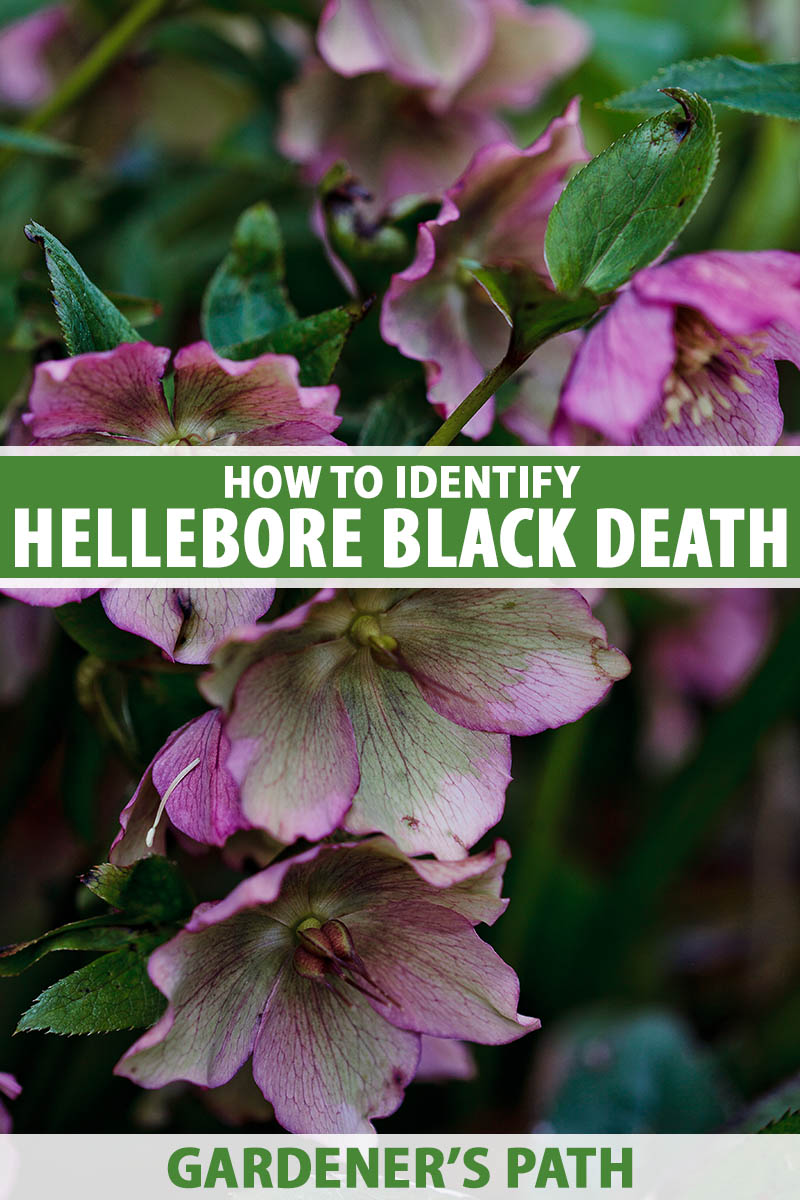
We link to vendors to help you find relevant products. If you buy from one of our links, we may earn a commission.
In ideal conditions, they are typically easy to care for and will return year after year to provide color in the bleak winter landscape.
Hellebore black death is a devastating viral disease that affects some hellebore species more than others.
Species and cultivars of Helleborus orientalis and H. x hybridus are the most vulnerable, and H. argutifolius and H. niger appear to be less susceptible.
Thankfully, this viral infection is fairly uncommon in home gardens.
While there is no cure, in this guide we’ll cover how to identify the symptoms of this fatal disease.
What You’ll Learn
Recent Discovery of Black Death
Symptoms of this disease were first reported in continental Europe and the United Kingdom in the early 1990s.
Over time, it has spread to the US, New Zealand, and Japan probably via infected nursery stock.
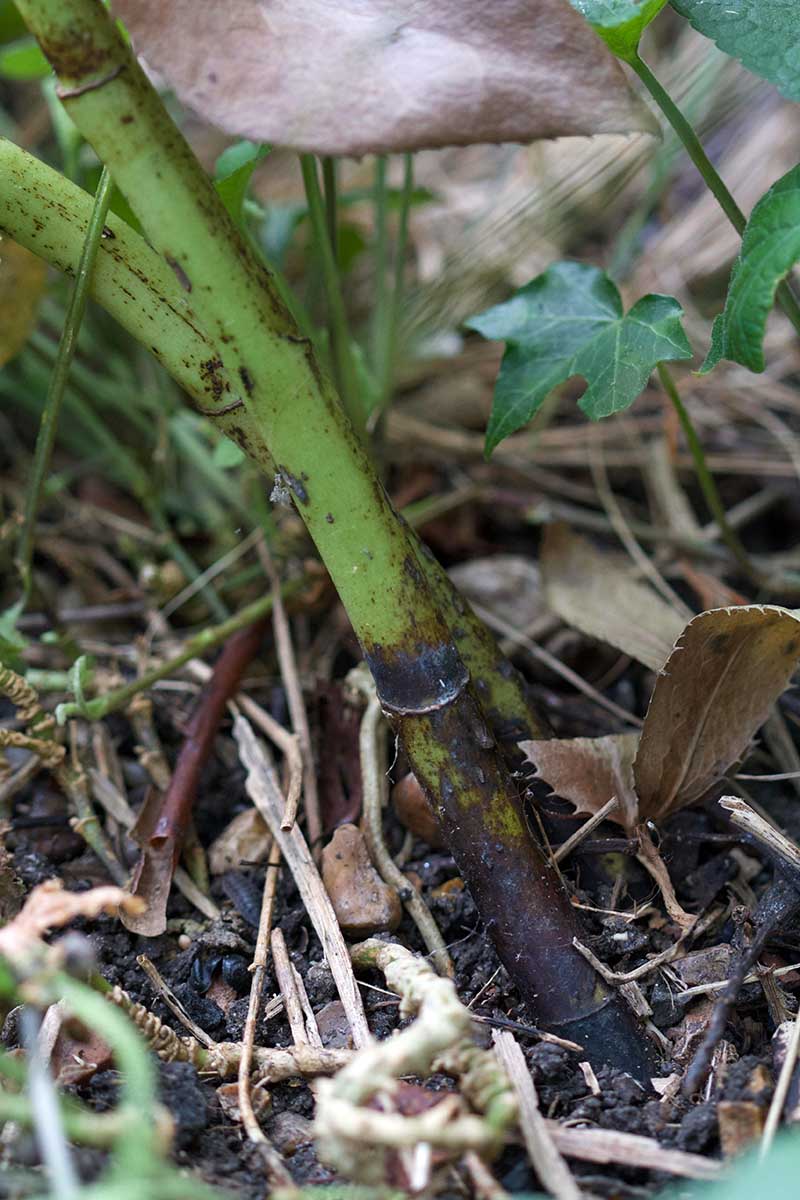
In the US, symptoms matching those of hellebore black death were first observed in a plant nursery in Washington State in 2000.
According to an article published in the journal Plant Disease, in 2009 scientists identified the cause of the symptoms commonly called “black death” as a new viral disease affecting hellebores, and named it the Helleborus net necrosis virus, or HeNNV for short.
HeNNV is classified as a Carlavirus, one of a number of species of plant viruses, typically spread by aphids, whiteflies, and infected gardening tools or machinery.
Several other viruses are known to cause disease in hellebores, including mosaic virus, Chrysanthemum virus B, Tomato spotted wilt virus, and Cucumber mosaic virus, but none are as devastating as HeNNV.
And none of them have been associated with the specific symptoms of black death.
Symptoms
Older plants are most likely to show symptoms, typically on newly emerging foliage and flowers.
The most striking appearance of this disease is black streaks on the surface of the leaves and on the main stem of the plant that is infected.
Additional symptoms can include:
- Black streaks on flower bracts
- Ring spots on petioles and bracts
- Brittle, severely stunted brown to black new growth
- Blackened leaf veins
In the early stages of infection, symptoms may appear to be similar to another, treatable, disease called fungal black spot (Microsphaeropsis hellebori).
While both black death and fungal black spot cause – you guessed it – dark spots on the leaves, in the case of black death they tend to follow the veins, and appear as streaks rather than blotches.
Typically, symptoms will become worse over the course of a few weeks, growth will be stunted, and the plant will eventually die.
Plants may be infected with this virus for up to 18 months before they start showing symptoms, but once symptoms are visible, the plant will not recover.
It is this long period of time when the plant may be carrying the virus, but appearing asymptomatic, that has contributed to its spread.
How to Limit Its Spread
HeNNV is not known to infect plants other than hellebores, so you don’t need to worry about it spreading to edible crops or other ornamentals in your garden.
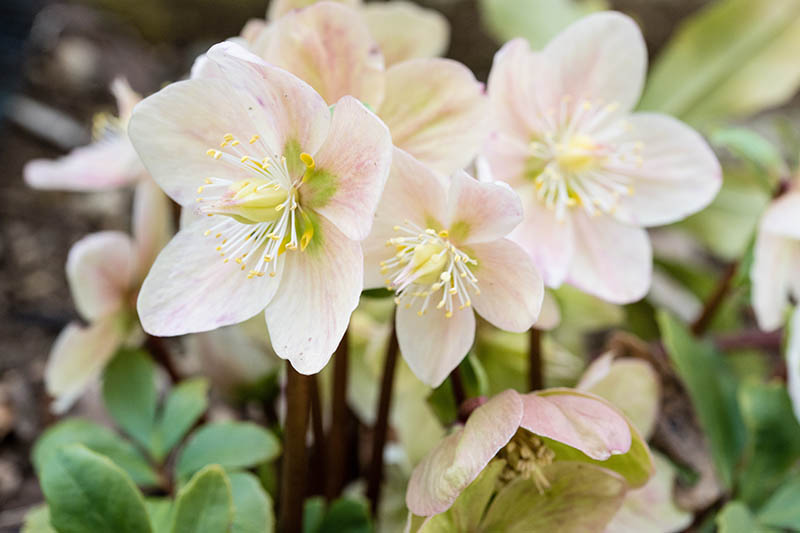
According to the Royal Horticultural Society, the hellebore aphid Macrosiphum hellebori has been identified as a possible vector for the HeNNV virus.
Aphids and whiteflies are common vectors for other plant viruses, spreading disease by feeding on the sap of infected plants and transmitting it to healthy specimens.
You can learn more about how to control aphids in our guide.
If you identify a plant that is likely suffering from this disease, you need to dig it up and remove it immediately, bag it up, and dispose of it in the trash, do not place it on your compost pile.
You will not know whether your other plants are infected until they start showing symptoms, so you can choose whether to leave asymptomatic plants in the ground, or to purge them as well, to ensure that the virus is eliminated.
Good gardening practices, such as disinfecting your pruning shears and other tools in between each use can help to prevent the spread of viruses and other pathogens.
A Dark, Deadly Virus
The only bright side in this story is that this disease is relatively rare in home gardens compared to nurseries and large plantings in display gardens.

Since it is highly contagious and there is no cure, you will have to ruthlessly cull any infected plants, and place them in the trash.
Have you encountered hellebore black death? Let us know in the comments section below.
And for more information about growing hellebores in your garden, check out these guides next:
- How to Grow Hellebores, the Winter-to-Spring Sensation
- The Many Faces of Hellebores: 6 Unique Types to Love
- How to Divide and Transplant Hellebores
© Ask the Experts, LLC. ALL RIGHTS RESERVED. See our TOS for more details. Uncredited photos: Shutterstock. With additional writing and editing by Clare Groom.
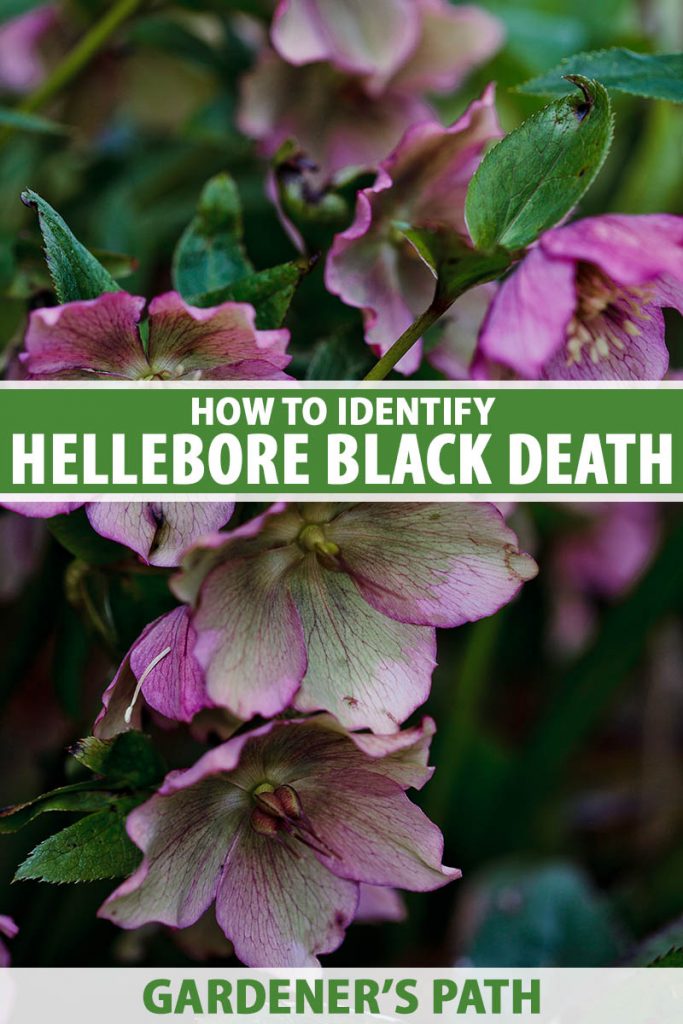
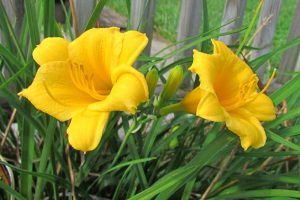
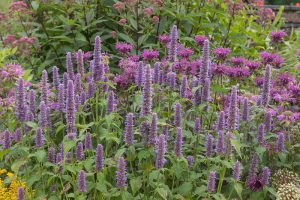
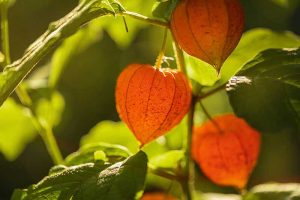
Thank you for this informative article. I had a beautiful garden bed filled with Hellebores. Last summer I found that nearly all the plants were covered with aphids, eventually turned black and ultimately died. I couldn’t find the underlying source of the necrosis until I read your article.
Hi Jeanne,
Thank you so much for your kind words and taking the time to tell us about your hellebores.
I am so sorry to hear that. It sounded heartbreaking. We were relieved to learn that hellebores in home gardens are usually not affected by that virus, and it’s horrible that your garden was an exception.
I moved into a home that has a large hellebore. I started googling what this could possibly be….and I think this may be it?
Hi Cyndi, I’m sorry that your hellebore plant is infected. Fortunately, there is another much more common pathogen that causes black spots on the leaves. It’s called hellebore black spot and is treatable unlike hellebore black death. I studied your picture in detail, since it can be difficult to figure out which pathogen is involved. I think that it is black spot. The brown spots from black death tend to follow the veins on the leaves, while those of black spot are more round. Also, check the stems at the base of the plant to see if they are black… Read more »
Well I now know that I have black death. My question is can I plant another plant in that spot safely? I want to get another hellebore, but am hesitant.
Hi Joan –
Oh, no!
As the vectors of hellebore black death are above-ground pests, such as aphids and whiteflies, it is unlikely that the virus is in the soil. However, if you have other hellebores in the vicinity of the one that succumbed to the virus, they may harbor the deadly virus, and the new plant be a potential victim.
I think I have just bought 3 helleborus foetidus with black death and planted them. 2 of the plants totally collapsed and died shortly after planting. The last one is seemingly OK, but I am watching it closely for any signs of disease.
I am now terrified that the disease may spread to my much loved, glorious collection of helleborus orientalis, some of which came from my mother’s garden.
It seems very irresponsible of nurseries to sell plants like this. They must be aware that they have the virus amongst their stock.
Hello Julie –
This is so sad to hear.
We recommend contacting the nursery from which you purchased your plants. As black death is uncommon in home gardens, it is possible that yours were infected with a different disease, and that is has come to their attention.
You can also contact your local agricultural extension to discuss the symptoms and how best to protect the remaining plant and the treasured ones from your mom.
In the meantime, do your best to control pests, like aphids and whiteflies, that are vectors of black death, as well as other diseases.
The ailment of my Hellebores does not look like the pictures from those gardeners that are responding. So , I applied ‘ Fertilome” anti fungal, and for
Bugs. I want to try anything , in order to save it. I will not give up, until it …..
Dies..????????????????
Hi Freda –
We’re so sorry to hear your plants are sick.
It’s possible that they are suffering form a different virus or fungal condition. An appropriate antifungal treatment, as well as pest management, can go a long way toward supporting plant health.
You can contact your local agricultural extension and/or hellebore society for help with diagnosis and treatment.
It’s so sad. For years I’ve had a lush garden with many of these roses. Last year a black fungus/disease attacked them. I spent a lot of time religiously cutting off diseased leaves and spreading fungicide on the ground. Now I have a sparse garden and what is left still looks infected (black area on leaves/stems, wilty/shriveled leaves, stunted single bloom if at all). It’s mostly just leaves and no blooms. Does this look like Black Death? The site isn’t letting me add photos, unfortunately.
I was able to add a few photos after all.
Last bunch of pics. Any advice is appreciated.
Hi Bryanne –
The symptoms appear to be more in line with black spot than black death. It also appears that a pest is eating the leaves.
You’ve done very well to remove the affected foliage. I think what you might try at this point is a product that addresses both the fungal infection and the pests.
Plant-based BONIDE® Captain Jack’s™ Neem Max, https://www.arbico-organics.com/product/bonide-captain-jacks-neem-max/pest-solver-guide-beetles is one we recommend.
If treatment fails, or you have further concerns, please contact your local agricultural extension and/or hellebore society for assistance with a firm diagnosis.
Thanks so much for your suggestion! I will definitely try the product you referenced. I’ve applied fungicide so many times; I was sure the plants would be healthy this year. That’s why I was starting to think it must be the “Black Death.” Actually, there are examples that look worse than the photos I posted but I’d already discarded them…wish I could have shown those. Fingers crossed it’s just the fungus!
Do you know how to find out who the local agricultural extension is? Is there a site to look this up on? Thanks!
Hi Bryanne –
You’re welcome. Here’s a link to help gardeners locate their local land grand university agricultural extension offices.
Thank you so much Bryanne for all the pics–that is exactly what mine looks like–and thank you Nan for commenting–i do hope my gigantic bed of hellebores (approx 40 big plants now, under a big old tulip magnolia tree) can be saved. I’ll be trying the Neem Max immediately.
Hello Kevin –
You’re welcome. Hopefully a fungicidal treatment is the answer.
I wish your articles had more pictures, especially to illustrate the difference between the diseases. Maybe it’s because I’m on a tablet I only saw one picture showing any symptoms and they were not as discussed in the narrative.
Hello Rubee –
We are sorry that you were disappointed by a lack of illustrative material to support the descriptive text in this article. If you are in need of a firm diagnosis, we recommend that you consult a local hellebore society or agricultural extension.
Great article, but I still can’t tell if what I have is hellebore black death or something else. I don’t see streaking so much. It looks more like the plant is just rotting! This is a mature plant. It was here when I purchased the property 2 years ago. Last year it started getting what looked like a fungus. I cut off and discarded all leaves late in the fall, though I probably didn’t do as good a job as possible of cleaning around the base of the plant. This is the first plant in a row of 6. The… Read more »
Hello Hank – We’re so glad you enjoyed the article. The spotting and dead patches appear to be consistent with black spot disease caused by the Microsphaeropsis hellebori fungus. If it were black death, we would expect to see streaking, rather than rounded patches of dead plant tissue. Black spot is more common than black death, and is especially vicious with wet weather, ground oversaturation, poor drainage, and overcrowding. Remove all affected plants and discard them in the trash. Sanitize your garden tools. Make sure that nearby plants are not overcrowded. Divide them as needed to improve air circulation. Treat… Read more »
Hello Hank –
We’re glad you found the article informative.
As fungal conditions are common, and hellebore black death is relatively rare, we always take the fungal approach first. An advanced fungal infection that leaves plants black and rotten may indeed resemble black death. The only way to know with certainty is to contact your local hellebore society for advice, or use this link to reach out to your local agricultural extension.
We have several infected patches and just dug one up entirely as almost all the plants were infected. So now we have a clean slate and can’t wait to start re-populating them. But my question is this. Can the virus live in the soil? Do we need to wait a period of time until we can replant or are we good to go once all the infected plants have been eliminated?
Hi Rick – My answer to Joan, who had a confirmed case of black death, was that as long as no other hellebores in the vicinity have the disease, it’s okay to repopulate the same area with fresh plants. This is because the vectors of black death are insect pests that live above ground. However, in your case, there may be speculation as to whether or not your plants had a fungal condition or black death, and as we know, fungal disease is more common. In the event that your plants suffered from fungus, the spores may indeed winter over… Read more »
Our back garden has multitudes of Lenten roses that were here when we moved in 4.5 years ago and have thrived with literally no care from me. Suddenly, within a week or two, MANY of them are dying. Like, it seems like it happened within days. Can you tell if this is Black Spot or Black Death or a combination? And the best course of action? Thank you!
Here are a few more photos
Hi Tracy –
We’re sorry to hear that your plants aren’t doing well. It appears that there are brown spots on the foliage, indicative of fungal leaf spot disease, as opposed to the black striations of hellebore black death. Remove badly affected plants in their entirety and apply a fungicide like neem oil to the remaining plants. Wet weather and overcrowding are the likely culprits for an infection of this magnitude.
As suggested to Rick, if you find you have to remove an entire garden, starting fresh with a preventative application of food grade diatomaceous earth may be warranted.
Thank you!